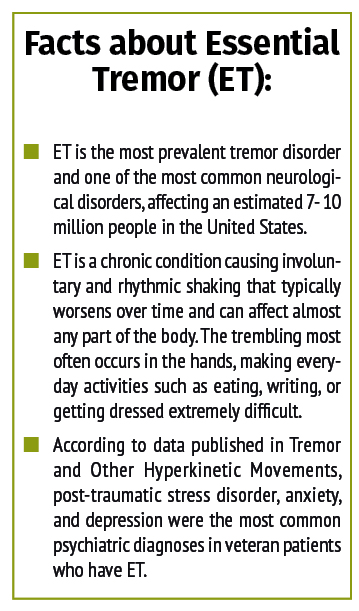How Bioelectronic Medicine Helped a Texas Veteran Get His Life Back

Bioelectronic medicine is on the path to helping many people who had no hope of getting their life back. Discover how this technology is helping Texas veterans like Ben Duncan.
Ben Duncan is one of the approximately 7-10 million people who suffer from essential tremor (ET) in the United States.
ET is the most prevalent movement disorder and one of the most common neurological disorders. It causes involuntary and rhythmic shaking, which is often mistaken for Parkinson’s Disease (PD), but ET affects 10 times more Americans than PD.
Ben first experienced symptoms of essential tremor 14 years ago. Ben was in the Air Force, stationed in Fort Worth. After serving as a military officer for 21 years, Ben became a successful professional in county government and aircraft manufacturing.
During the first year following his diagnosis, Ben experienced a downward spiral. He said the tremors turned his life upside down: He was unable to ignore his symptoms, which at times were so severe he was ultimately forced to retire early.
This progressive, debilitating neurological disorder impeded Ben’s ability to dress himself, write, type, and perform his love for wood crafts. As the tremor progressed, it ultimately prevented him from doing daily tasks like feeding himself and walking.
Ben’s symptoms impacted his life in such a severe way that he experienced increasingly intense bouts of depression, anger, and boredom — things he’d never previously experienced. Ben said his tremor made him feel practically useless and as though he had lost everything in life. It ultimately robbed him of his self-worth and self-confidence, which eventually led to suicidal thoughts.
In describing his journey with essential tremor, Ben spoke of a gas gauge in an automobile.
“Prior to developing essential tremor, my gas gauge was ‘topped off,’” he said. “I had a normal productive life and was extremely active in work and in my community.”
His hand tremors worsened over the years to the point his wife needed to spoon-feed him on “bad” tremor days. He did not know what each day would bring with this condition. He considered his right arm utterly useless and described it as “a dead arm” due to the constant tremors.

Ben made appointments with his primary care doctor and a neurologist. When he was diagnosed with ET, his neurologist prescribed multiple prescription medications. These medications resulted in severe side effects for Ben, such as loss of balance, dizziness, sleeplessness, and fatigue.
At the maximum strength of these medications, he felt like his “gas gauge” was still only 60% full, and the debilitating tremors were still present. He could only use his right arm when he was having a “good day.”
Bioelectronic Medical Therapy
The medications weren’t cutting it. Ben’s neurologist gave him three choices. First, deal with the devastation of tremor and the side effects of medications. Second, undergo brain surgery, which was not guaranteed to work and something he greatly feared. Or, third, use a newly FDA-cleared non-invasive bioelectronic medical therapy.
Ben chose bioelectronic medicine as his path, which was the Cala device: The first non-invasive targeted therapy that reduces hand tremors for adults living with ET. It’s a simple wrist-worn device calibrated to treat a patient’s unique tremor frequency. The Cala device stimulates the nerves in the wrist, which disrupts the tremor network in the thalamus of the brain and provides meaningful tremor reduction without the need for invasive brain surgery. Ben and his doctor decided to give it a shot.
Initially, Ben experienced a couple of hours of tremor relief after using the therapy. As he continued his treatment schedule, he noticed a greater reduction in tremor. Now he receives 10-12 hours of tremor relief. He said he feels like he’s back to near-normal functioning and that his “gas gauge” is topped off at a “full” level again. By working with his doctors, Ben has weaned himself off all medications.
Ben experienced a dramatic change in his life and can now do almost all things he used to take for granted. His writing and penmanship have improved significantly, and his typing skills have returned. He can grasp and properly use items like a cup or spoon, and he enjoys woodworking again as he can now use his right hand for fine detail work. Ben still has a few limitations but has regained a lot from his treatment.
Ben learned he needed to be persistent and work with his healthcare providers to get the best treatment. He said he wants to encourage others with chronic conditions to open a dialogue with their healthcare professionals, take control of their health, and get an accurate diagnosis. He shared his story so others like him are motivated to advocate for themselves and take ownership over their healthcare.
To see a video of Ben talking about his journey with essential tremor, visit www.calatrio.com/veterans.






